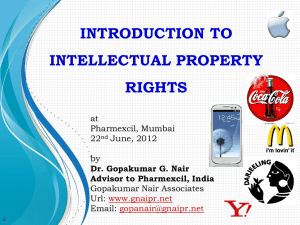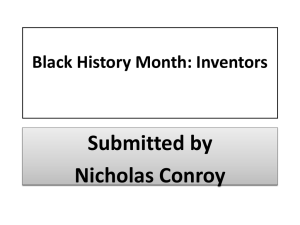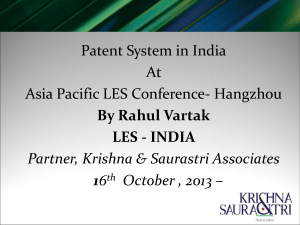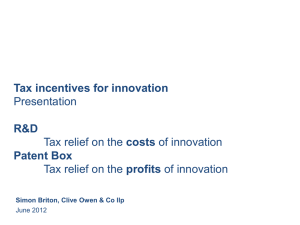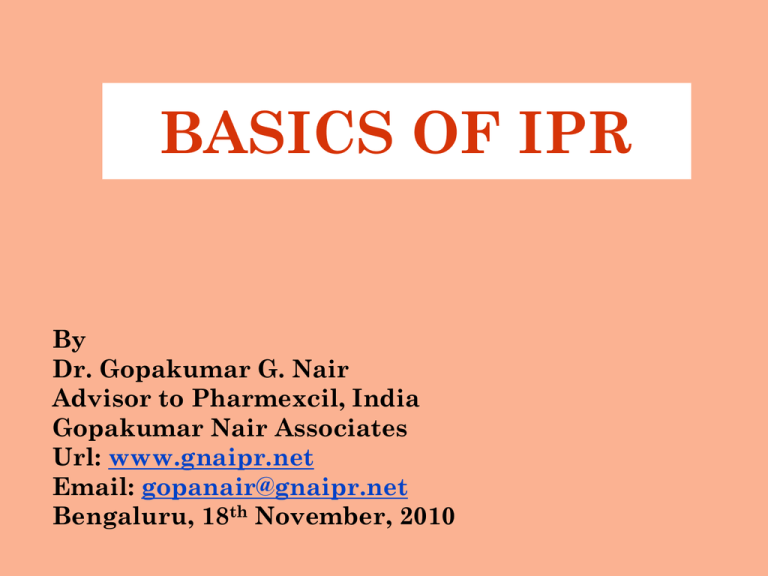
BASICS OF IPR
By
Dr. Gopakumar G. Nair
Advisor to Pharmexcil, India
Gopakumar Nair Associates
Url: www.gnaipr.net
Email: gopanair@gnaipr.net
Bengaluru, 18th November, 2010
Think Away From The Box
GENERATE IDEAS…..
AND OWN THEM…..IPR !
“The test of an innovation, after all,
lies not in its novelty, its scientific
content or its cleverness. It lies in its
success in the market place”
Peter F. Drucker
"Innovation now is more of a relay race
than a marathon.….The baton of an idea
might start at a university and move to
multiple
companies
before
being
commercialized.
"Of course, batons can be dropped along
the way”.
- Henry Chesbrough, ED
Center for Open Innovation,
Haas School of Business,
University of California, Berkeley
Source: William M. Bulkeley, Gautam Naik and Justin Scheck Wall Street Journal/Livemint
TRIPS
The TRIPS (Trade Related Aspects of
Intellectual Property Rights) Agreement
came into being with the establishment
of the WTO (World Trade Organization)
effective from 1st January, 1995.
TRIPS
Intellectual Property Rights itself is
defined, in the context of the TRIPS
as a Right given to people over the
Creations Of Their Minds.
It usually gives the Creator an
Exclusive Right over the Use of his
Creations for a Certain Period Of
Time.
WIPO
UN organization dedicated to promoting
the use and protection of works of the
human spirit.
Headquarters in Geneva, Switzerland.
184 nations as member states.
Manages all IPs.
Training through Academy and Seminars.
IP EVOLUTION
Property Right
INTELLECT – PROPERTY – RIGHT
Idea Expression COPYRIGHT
Idea Innovation Invention PATENT
Idea Quality + Identity TRADEMARK
Idea Appearance DESIGN
Idea Keep Confidential
No Disclosure
TRADE SECRETS
IP PORTFOLIO
INTELLECTUAL
PROPERTY RIGHTS
Patents
Trade Marks
Designs
Copyright
Others
QUASI
INTELLECTUAL
PROPERTY RIGHTS
Confidential
Information
Know How
Trade Secrets
Reputation
IP PORTFOLIO
CONTD…..
Others: G.I, CBD, UPOV,
IC Layouts,
Related Rights
Neighboring Rights
Domain Names
Others: Data Exclusivity
Brand Loyalty/Goodwill
House Name
Client / Customer Lists
Market Intelligence
Test Methods
In-house Stds/Specs
Impurity Profiles
Management Practices
PRODUCT PATENTS IN INDIA
IP PORTFOLIO
Novel &
Inventive
Patent US7395821
Copyright
Trademark
MultiHaler™
Package Insert/
Information
Leaflet
Trade Secret
Know-how
TM (Amend) Bill,
2009 passed by
Rajya Sabha on
10/08/2010
External
Appearance
Confidential
Informn
&
Undisclosed Tech
Design
No. 211208
INNOVATIONS
Sources
Incremental
Need-based
Intensive
Innovations
Solutions
Research
Disruptive
inventions
Serendipity
THE EVOLUTION
THE EVOLUTION
(Indian) Patents Act, 1970 is fast
evolving through Jurisprudence
(similar to US Laws 35USC).
Indian Patent Law & provisions
thereof,
being TRIPs plus on Patentability &
being TRIPs plus on Public Interest,
with equitable balance between
Rights & Obligations is fast evolving
as a Model law for LDCs & DCs
FOR
COMPLIANCE WITH TRIPS’ PROVISIONS
Amendments to Patent Act, 1970
1st Amendment, 1995 / 1999
2nd Amendment, 2002 / 2003
3rd Amendment 2004 / 2005
&
Rules, thereunder.
WHAT IS A PATENT ?
A patent is a protection given to a patentee for
an invention for a limited term by the
government for disclosing the invention
Right to exclude others from using your
invention.
Owner has a qualified right to use the
invention
WHAT IS A PATENT ?
A conditional grant
Balance of Rights and Obligations
Subject to other laws of land
Granted to owner of invention/assignee
(Recent judgments of HC and SC takes note of
third party interests in granting / refusing
injunctions)
Three Statutory Benchmarks for Patentability as per
the Patents Act, 1970:
1. Novelty
2. Inventive Step (Section 2(1)(ja))
3. Industrial Applicability (Section 2(1)(ac))
PATENT - PATENTABILITY
An invention can be patented if it is
NOVEL: Must be New,
Must DISTINGUISH from “State of the Art”
(PRIOR ART)
Must have INVENTIVE STEP
Non-obvious to a person “Skilled in the Art”
Must have INDUSTRIAL APPLICATION
Must be Useful
Must have Utility
Must not be covered by Sec. 3 and Sec. 4.
NON-OBVIOUS
THE DIFFERENCES BETWEEN THE
CLAIMED INVENTION and the PRIOR ART
are such that the subject matter as a whole
WOULD NOT HAVE BEEN OBVIOUS at the
time the invention was made to a PERSON
SKILLED IN THE ART, to which the subject
matter pertains.
Famotidine
NCE/NME
API
Product Patent
Tiotidine
Process Patent
‘Me too’ derivatives – Imatinib, Erlotnib
Formulation
Dosage Forms – Tablet, Capsule, etc
Release Profile – Controlled, Slow etc.
NDDS - Transdermal Patches,
Transmucosal Drug Delivery.
New Use – Aspirin (analgesic & blood
thinner)
INVENTIVE STEP
Section 2 (1)(ja):
"inventive step" means a feature of an
invention that involves technical advance
as compared to the existing knowledge
or having economic significance or both
and that makes the invention not obvious
to a person skilled in the art.
INDUSTRIAL APPLICATION
(UTILITY)
Be Useful.
Must work / be workable.
At least one recognized, verifiable
and practical end-use.
PATENTS ACT, 1970
What is not Patentable
(a) Frivolous, Contrary To Natural Laws
(b) Contrary To Public Order Or Morality,
Prejudice To Human, Animal Or Plant
Life Or Health Or To The Environment;
(c) Mere Discovery Of Scientific Principle,
Abstract Theory, Living Thing Or Nonliving Substances
(d) Mere Discovery Of New Form, New
Property, New Use Of A Known Process,
Machine Or Apparatus (EFFICACY)
PATENTS ACT, 1970
What is not Patentable
(e) Mere Admixture (SYNERGY)
(f) Mere Arrangement, Re-arrangement,
Duplication of known devices.
(g) Omitted (Testing Methods)
(h) Method Of Agriculture Or Horticulture;
(i) Method Of Treatment.
(j) Plants, Animals, Including Seeds Varieties,
Species, Biological Processes.
Exception: Microorganisms
PATENTS ACT, 1970
What is not Patentable
(k) Mathematical Or Business Method Or A
Computer Program Per Se Or
Algorithms;
(l) Literary, Dramatic, Musical Or Artistic
Work, Other Aesthetic Work
(m) Mere Scheme, Rule, Method Of
Performing Mental Act, Playing Game;
(n) A Presentation Of Information;
(o) Topography Of Integrated Circuits;
(p) Traditional Knowledge
INDIAN PATENTS ACT & RULES AS
AMENDED UP-TO-DATE HAVE MANY
FEATURES WHICH ARE CURRENTLY BEING
ADOPTED
/ ADAPTED
GLOBALLY
Ex: Sec 3(d) - Enhanced Efficacy essential for
inventiveness in new forms of already known
pharma substances. (Gleevec Case)
Ex: Sec 3(e) - Synergy required in mere combinations.
(Decision of the Controller in application No.
IN/PCT/2002/00020/DEL)
Ex: Sec 3(f) – Mere arrangement or rearrangement
(KSR v Teleflex)
Ex: Sec 3(d) – Business Method, per se. (In Re Bilski)
PATENTABILITY FILTER
Prior use/ prior publication/ prior disclosure
Industrial applicability
Novelty
Non-obviousness- inventiveness
Sec. 3- Not patentable
Written description / enablement
requirements
Application/ specification/ claims
Patent prosecution
Maintenance / Defense after grant
PATENT GRANT PROCEDURE
Filing of patent application
Early Publication
Prior art search
Publication after 18 months
Request for examination
Pre Grant Opposition /
Representation by any person.
Examination: Grant or Refusal
Publication of Grant of patent
Post Grant Opposition to grant of patent
(Constitution of Opposition Board)
Decision By Controller
INDIAN PATENT OFFICE PROCEDURES
Inventor & Consumer friendly. (Balance of Rights & Obligations).
Research & Regulatory Exemption during Patent Life (Sec 47(3),
Sec. 107A(a)).
Four Patent Offices in four regions (Unique to India).
IAS - Senior Techno-legal officer appointed as CG.
Patent Office procedures revamped, revitalized, digitalized and
made transparent.
Out of box solutions being implemented to expedite office actions.
India becoming ISA / IPEA.
PATENTING IN INDIA
Process Patent – Largely used to defend against
Sec. 104A (reversal of burden of Proof)
Composition (FDC) Patents – India has the best
experience globally; NDDS
(Fixed Dose Combination)
substantially driven by
DPCO / NPPA comparisons.
Herbal Patents – High Potential; negatively impacted
(Natural product
by impractical NBA (CBD - BA)
(Benefit Sharing)
based)
Plant Varieties – High Potential (PVPFA).
NCE/NME Drug Discovery Patents
TRIPS PLUS –
TOUGHER PATENTABILITY
(Balance against unfair monopoly)
1. Inventive Step & Sec 3
2. Pre & Post grant opposition
3. Revocation through IPAB
4. Counter-claim for revocation in an infringement suit.
COMPULSORY LICENSING
GOVERNMENT USE
RIGHTS & OBLIGATION/EXEMPTIONS OF PATENTEE(S)
RIGHTS
Exclusive right to make,
use, sell or import the
patented invention.
Exclude others from
unauthorized use of the
patented invention.
Grant licenses, Assign
rights or enter into
agreements.
To sue others for
infringement.
To surrender patent rights.
quid pro quo
OBLIGATION/EXEMPTIONS
Disclosure of the invention
Exemption for research,
experimentation, imparting
instructions to pupils.
Use of Inventions for
Government’s own purposes or
for public services.
Acquisition of Inventions by
Central Government.
Compulsory License / 3rd Party
use.
Prohibit or Restriction of
publication of patent
information considered relevant
for defense purposes.
CBD
CONVENTION ON BIODIVERSITY
TRADITIONAL KNOWLEDGE
UPOV
Plant Varieties Protection Act (Art 27.3b)
Data Exclusivity (Art 39.3)
INDUSTRIAL DESIGNS
TRIPS
Part – II,
Sec.4
Art. 25 & 26
Must appeal to the eye
Ornamental or Aesthetic aspect of
an article.
3-D or 2-D features such as shape or
surface, patterns, lines or color.
Industrial designs are applied to
products of industry and handicraft,
technical and medical instruments,
watches, jewelry, house wares,
electrical appliances, luxury items,
vehicles, architectural structures,
textile designs.
Double Syringe
Does not protect any technical
features of the article to which it is
applied to.
DESIGNS
Indian Designs Act, 2000 & Rule, 2001 (amended
upto 2008).
To promote and protect the design element of
industrial production.
Aimed to enact a detailed classification of design to
conform to the international system and
To take care of the proliferation of design related
activities in various fields.
DESIGN PATENT
Title: A Dispensing Device for Bioassay Method
1. Design No. 196748 dated 12th August 2004
2. Design No. 196749 dated 12th August 2004
Patentees – Khale Sangeeta Shailesh and
Khale Ashok Shamrao
TRADEMARKS
TRIPS
Part – II, Sec.2
Art. 15 to 21
Word Mark
Device Marks
(Signs, Symbols, Logos)
Collective Marks
Certification Marks
Service Marks
TRADEMARKS
Must be graphically represented
Must be distinctive / distinguishable
Must not be descriptive
Must not be deceptively similar to known /
well-known marks /Generics
• Frusemide – Lasix/Frusemex
• Cefixime – ZIFI, CEFI, Cefixin
Avoid –
Geographical Indications / Deities
National Leaders / Heroes / Symbols /
Laudatory words
PHARMACEUTICALS IN TRADEMARKS ACT
While proceeding for Marketing Approval,
adopt caution while choosing Brand Names
Case Study:
Zydus Cadilla v Sun Pharma
Trademark violation suit regarding an antidepressant drug
Venz OD of Zydus and
Veniz XR of Sun Pharma.
Active ingredient---VENlafexine
Sec 13: Prohibits registration of INN as TM
RECENT TRADEMARK CASE
4th May, 2010
Application seeking use of Gandhiji’s image on
Montblanc pens rejected
Solicitor
general
Gopal
Subramaniam assured the Bench
headed by Chief Justice K G
Balakrishnan that the Centre has
refused permission to Mont Blanc
for use Gandhi's image on their pens
on the ground that use of word or
picture of Mahatma Gandhi being
a national emblem cannot be used
for commercial purpose.
COPYRIGHTS & RELATED RIGHTS
TRIPS
Part – II, Sec.1
Art. 9 to 14
What is Copyright ?
Copyright is a legal term
describing rights given
to creators for their
literary and artistic
works.
COPYRIGHT
What is covered by Copyright ?
The kinds of works covered by
copyright include : literary works such as
novels, poems, plays, reference works,
newspapers
and
computer
programs;
databases; films, musical compositions, and
choreography; artistic works such as
paintings, drawings, photographs and
sculpture; architecture; and advertisements,
maps and technical drawings.
COPYRIGHT - EXTENSION
IT Revolution !
Recordings
Broadcastings
Audio visual works
Computer programs
Digital databases
Internet/web
Cable and Satellite T.V.
Copyright Amendment Bill, 2010
Amitabh Bachchan to copyright his voice!
IPR AND COPYRIGHT
Quoting Medical References from Journals and Books
“Copyright” / “All rights reserved”
“Do not use, reprint, reproduce or distribute without prior permission”
Avoid verbatim reproduction - Likely to cause
Copyright violations.
Always acknowledge / obtain prior permission.
Abstract / Summary may be written in one’s
own language / quote the source.
Copyright violations could lead to
criminal/civil suits
Could lead to imprisonment too !
Be Aware / Beware of the Web /
Domain in the new global regime.
× Use of internet for selling / marketing
× Downloading from Internet (except for
personal use)
MUST ALWAYS HONOUR IPRs
(Copyrights, Patents etc.)
RECENT COPYRIGHT CASES
Chetan Bhagat Vs 3 Idiots
• Oct, 2010 - Kolkata HC declares that Sa Re Ga
Ma has the right to grant License.
• April 2010 - Kolkata HC restrains the use of
the song Apni Toh Jaise Taise’ from ‘Laawaris’
in the movie ‘Houseful’.
DISTINCTION AND DEGREE OF PROTECTION
Copyright – Expression of ideas
– Protection is specific and its
protection scope is fairly narrow
(Narrow Protection)
Patents – novel idea itself when applied and
useful.
– can cover a relatively broader scope
including various applications or
programs.
(Broad Protection incl. Equivalence)
PHARMACEUTICALS IN DESIGN ACT
Shape, size, colour etc.
Eg: US patent D380825
granted to Merck & Co.,
Inc.
PHARMACEUTICALS IN COPYRIGHT ACT
Package Inserts /
Information Leaflet
G.I.
(GEOGRAPHICAL INDICATIONS)
TRIPS
Part – II, Sec.3
Art. 22 to 24
Geographical Indications of goods
are defined as that aspect of
industrial property which refer to
the geographical indication
referring to a country or to a place
situated therein as being the
country or place of origin of that
product. Typically, such a name
conveys an assurance of quality
and distinctiveness which is
essentially attributable to the fact
of its origin in that defined
geographical locality, region or
country.
GEOGRAPHICAL INDICATION
India, as a member of the World Trade
Organization (WTO), enacted the Geographical
Indications of Goods (Registration & Protection)
Act, 1999 has come into force with effect from
15th September 2003.
Geographical Indications of Goods
(Registration & Protection) Act, 1999
Geographical Indications of Goods
(Registration & Protection) Rules, 2002
GEOGRAPHICAL INDICATION
What is a Geographical Indication ?
It is an indication.
It originates from a definite geographical
territory.
It is used to identify agricultural, natural or
manufactured goods.
The manufactured goods should be produced
or processed or prepared in that territory.
It should have a special quality or reputation
or other characteristics.
GEOGRAPHICAL INDICATION
Examples of Indian GI
Basmati Rice
Darjeeling Tea
Kanchipuram Silk
Alphanso Mango
Nagpur Orange
Kolhapuri Chappal
Bikaneri Bhujia
Agra Petha
Goa Feni
Palakkadan Matta
Navara Rice
RECENT GI CASE
Tirupati Ladoo
• October, 2010 - Rectification Petition filed with GI Registry.
• June, 2010 - Madras High Court dismissed the petition on
the grounds that alternate remedy of rectification under the
GI Act has not been exhausted.
• Oct, 2009 - PIL filed by J Mohanraj in Madras High Court
challenging the grant of GI for ‘Tirupati laddu’.
• Sept, 2009 - GI granted to Tirumala-Tirupati
Devasthanams.
THE INDIAN ‘BAYH DOLE’ BILL
Public Funded R&D (Protection, Utilization and
Regulation of Intellectual Property) Bill, 2008.
A Bill to Organize, Promote, and Regulate the
Public
Availability
of
Intellectual
Property
originating from Government Funded Research
and Development.
THE INDIAN BAYH DOLE BILL
CONTD…..
Salient Features
To Promote Creativity and to Provide Incentives for
creativity.
To provide Access To Innovation to all significant
stakeholders For Public Good.
Imposes Obligations and creates Rights to optimize the
potential of Government in R&D.
To promote collaboration between government, private
enterprises and non-government organizations; to
Promote Commercialization of IP generated out of
Government funded R&D and to promote the culture of
innovation in the country.
To increase the responsibility of Universities and
Research Institutions to encourage students,
faculty and scientists to innovate.
USEFUL LINKS
http://www.patentoffice.nic.in
http://www.wipo.int
http://www.uspto.gov
http://ep.espacenet.com
http://ipindia.nic.in/girindia/

